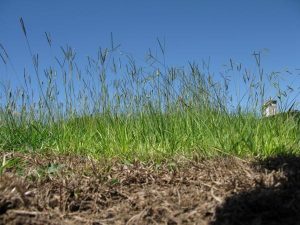
Furman’s campus is beautiful. Perfectly trimmed grass and bushes, pretty flowers everywhere. It’s beautiful… until you get to the Greenbelt. The landscape of the Greenbelt consists of really tall but patchy grass, and a few trees. While the landscape provides the houses with good shade and privacy, there is a big problem, as any Greenbelt resident has noticed, with clay runoff.
The grass planted around the houses is very tall, but is a clump type grass that allows for a lot of extra space between each plant, and because the houses are on an incline, any rain that runs down the slope takes a lot of clay with it. Now, if any of you have ever been riding down a state highway, or an interstate, you may have noticed the grass that grows fairly tall and blows as trucks pass it; this is bahiagrass. Bahiagrass is planted along the roads for multiple reasons: it is extremely tolerant to high heat, and it grows and spreads very quickly to eliminate any kind of erosion along the roadways.
I believe that the landscaping around the Greenbelt should definitely take planting this type of grass around the houses, in addition to the grass and plants that are already there. Bahiagrass goes to seed very quickly, and any time the wind blows it spreads itself out until, like you see along roads, it is covering every bit of dirt. Beyond just the erosion issues, bahiagrass can grow very tall (though not as tall as the grass that is already planted), and it can grow very thick as well. This grass would NOT be cut by the landscapers, and would therefore grow up to 2-3 feet tall, and would cover all of the dirt in a very short amount of time after planting. This tall grass would shade the soil, which would keep soil temperatures low and allow the grass to continue growing and spreading, which would in turn lower the level of clay erosion, and make the soil around our quaint little village healthier and sturdier.
-John Martinson
Source: https://www.ctahr.hawaii.edu/sustainag/cc-gm/bahiagrass.html